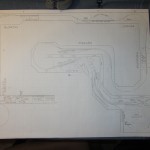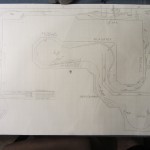My old Canadian Arctic Railway layout was planned to use dual 4′ T8 fluorescent fixtures mounted above each level. I’d never been particularly happy with that solution, since even the decent-quality electronic ballasts would buzz slightly, and the fixtures were completely un-dimmable. Plus, I always had some residual concerns about UV light from the bulbs damaging scenery.
I’ve been convinced for some time that LED strip lights were the way of the future. Small, silent, efficient, easily controlled (they’re only 12 volts!), and available in a wide variety of colors, strip lighting seems to promise massive improvements over under-layout fluorescent fixtures. The downside is the need for very large 12V power supplies and – until recently – the pure cost of it. Fortunately, with recent advances in LEDs and direct access to Chinese vendors via eBay and Alibaba, those two concerns have largely gone away.
In addition, the infinite dimmability of LEDs and the variety of available colors opened up the possibility of something I’ve wanted to try for a long time – modeling the day/night cycle! The basic idea would be to have the layout lighting adjust the intensity and color blend based on the fast clocks, so that as the day progresses, dawn grows into mid-day, which fades to afternoon and the “golden hour”, which gives way to the “blue hour” and then eventually night. With the right mix of colors and some simple power controllers attached to the MRBus layout network, such a thing should be relatively simple.
I ordered three 5 meter spools of 5050 (5.0mm by 5.0mm component) LED strips from China via eBay (my secret source…): one warm white (3200K), one cool white (6500K), and one blue. After two weeks of waiting on the proverbial slow boat from China, they arrived this afternoon. I wasted no time getting them downstairs, finding a suitable 4 ft. board (same as the fluorescent fixture), and cutting off strips to test.
I finally settled on 3 warm white and 1 cool white strip, when lit together at 12V, gave me similar lighting to the old tubes. One cool white and one blue strip, lit at about 10% power, gave me a reasonable “night”. No, it’s not as dark as a real night, but it’s a decent approximation for my operators.
No mix I could find, however, gave me a suitable sunrise or sunset color, so I’ve ordered another strip of 5050 RGB LEDs. I’m hoping that by using the warm and cool white strips as the “bulk” light, and then “flavoring” it slightly with color from the RGB strip, I can get satisfactory colors for all times of day. More to come once those LEDs get here…
I’ve included pictures of this evening’s test below.
Also, as a teaser, the first part of my CR&NW’s roster showed up today… Meet the 600s, a set of 6 SD60M three-window units that will eventually be numbered 600-605. (Yes, there’s a spare shell there, just in case I’m not as good with the ol’ airbrush as I used to be.) Obviously with the real CRNW calling it quits in 1938, they never had diesels. However, as I’ve mentioned, mine will be set in the present day. In my world, the SD60Ms showed up on the property in 1990 to replace the aging fleet of SD9s that had originally replaced steam in the 1950s. But more on my fictional modern day roster another day…













